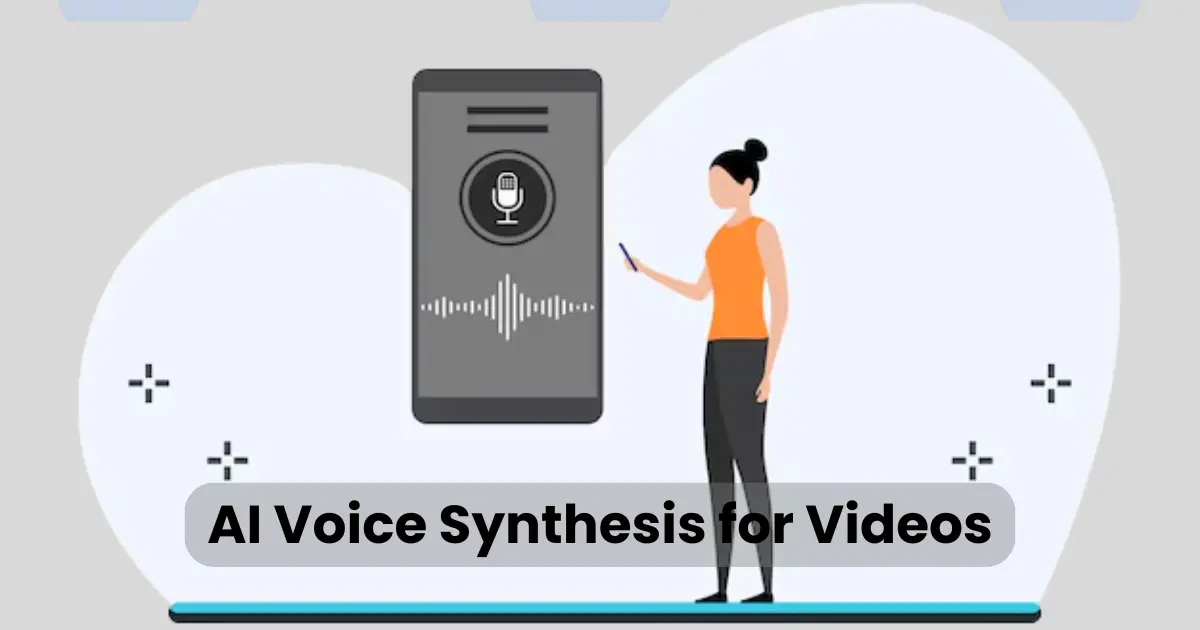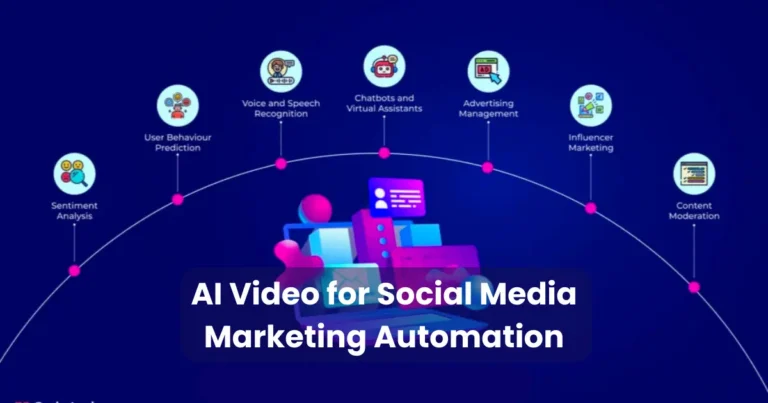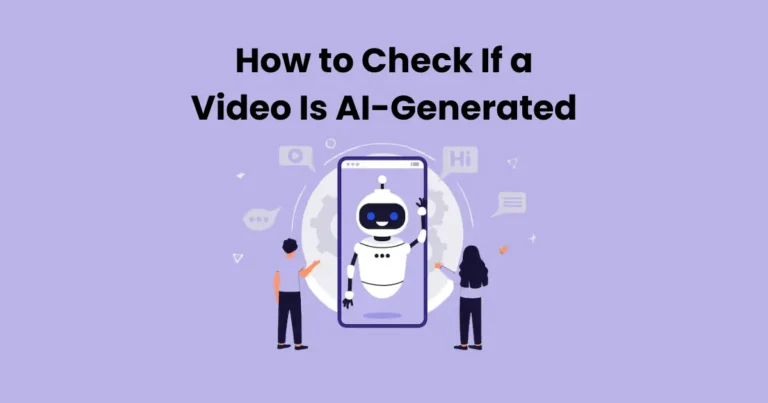AI Voice Synthesis for Videos | Popular Tools for AI Voice Synthesis

Contents
- 1 What is AI Voice Synthesis?
- 2 How AI Voice Synthesis Works in Video Production
- 3 Benefits of Using AI Voice Synthesis for Videos
- 4 Popular Tools for AI Voice Synthesis
- 5 Use Cases of AI Voice Synthesis in Different Industries
- 6 Future of AI Voice Synthesis in Video Creation
- 7 Tips for Choosing the Best AI Voice Tool
In today’s content-driven era, AI voice synthesis for videos is transforming the way creators and businesses produce audio for their visual content. Instead of relying solely on human voice actors, automated voice technologies are being used to deliver clear, professional, and realistic narration—often in just minutes.
As video content continues to dominate marketing, education, and entertainment platforms, the demand for fast and affordable voiceovers has never been higher. Thankfully, advancements in artificial intelligence are making this more accessible than ever. With high-quality synthetic voices now available at scale, creators can streamline production, maintain consistency, and localize content for global audiences—all while saving time and money.
What is AI Voice Synthesis?
At its core, AI voice synthesis for videos refers to the use of artificial intelligence to generate human-like speech from text. This technology, also known as text-to-speech (TTS), relies on deep learning models that analyze linguistic patterns, vocal tones, and emotional cues to replicate natural speech.
Moreover, AI voice synthesis is built upon advanced neural networks that have been trained on thousands of voice samples. These systems learn the rhythm, pitch, and intonation of real human voices, enabling them to recreate speech that sounds remarkably authentic. As a result, the synthesized voice can effectively narrate content for videos without requiring a live voiceover session.
Unlike traditional TTS engines, which often produced robotic and flat audio, today’s AI-powered synthesis tools are dynamic and expressive. Additionally, many platforms now allow customization options such as tone adjustment, pacing control, and even emotional styling—making the output sound even more human.
Overall, this technology not only enhances the viewer experience but also offers a scalable solution for creators looking to maintain consistent branding across multiple videos.
How AI Voice Synthesis Works in Video Production
The process of using AI voice synthesis for videos begins with a script—either manually written or auto-generated. Once the text is finalized, it is uploaded to a voice synthesis platform that processes the content and converts it into lifelike speech using artificial intelligence algorithms.
First, the text is analyzed linguistically. The AI determines sentence structure, punctuation, emphasis, and context. Following this, a neural voice model is selected. This model, trained on real human speech, maps the input text to phonetic patterns and emotional cues. As a result, the output sounds natural and expressive.
In addition, creators can often tweak parameters like tone, speed, and pauses. These adjustments help match the narration to the pacing of the video. For example, an educational tutorial may use a slower, clearer voice, while a fast-paced commercial might require energetic delivery.
Once the voice track is generated, it is synced with the visual content. Many platforms offer timeline tools, allowing voice clips to be dragged and dropped directly into the video timeline for precise alignment.
Because of this seamless integration, AI voice synthesis for videos has become an indispensable part of modern production workflows. It reduces turnaround time, ensures consistency, and empowers creators to deliver professional content with minimal effort.
Benefits of Using AI Voice Synthesis for Videos
The use of AI voice synthesis for videos brings a wide range of benefits to content creators, businesses, educators, and marketers. As technology continues to evolve, these advantages are becoming increasingly valuable in both small-scale and large-scale productions.

1. Time-Saving Production
One of the biggest advantages is speed. Traditional voiceovers require scripting, hiring voice actors, recording, and editing—all of which are time-consuming. In contrast, AI voiceovers can be generated within minutes, allowing creators to meet tight deadlines effortlessly.
2. Cost-Effectiveness
Hiring professional voice actors can be expensive, especially when creating content in multiple languages or dialects. AI voice synthesis dramatically reduces production costs while still delivering high-quality audio. Therefore, it’s ideal for startups and small teams with limited budgets.
3. Scalability and Consistency
Because synthetic voices can be cloned and reused, they help maintain a consistent brand voice across all video content. Whether producing hundreds of product videos or ongoing training materials, consistency is ensured without needing to rehire talent.
4. Multilingual and Inclusive Content
Many AI voice platforms support dozens of languages and accents. As a result, global audiences can be reached more easily, and content becomes more inclusive. Some tools even offer regional dialects and emotional tones, adding further authenticity.
5. Accessibility and Flexibility
With AI voice synthesis for videos, updates and revisions are hassle-free. If a video script needs to be modified, the voiceover can be regenerated instantly—no need to schedule new recordings. This flexibility supports agile production and frequent content updates.
In conclusion, the technology doesn’t just replace human narration—it enhances and streamlines the entire production pipeline, making it an essential tool in modern video creation.
Popular Tools for AI Voice Synthesis
As demand grows for fast, high-quality voiceovers, many platforms have emerged to offer powerful solutions in AI voice synthesis for videos. These tools vary in features, pricing, and voice quality—but all aim to simplify audio production for creators and businesses alike.

1. Google Cloud Text-to-Speech
Developed by Google, this tool offers over 220 voices across 40+ languages. It uses WaveNet technology to produce realistic and expressive voices. Additionally, it integrates easily with video platforms through API support.
2. Amazon Polly
Amazon Polly is known for its speed and affordability. It supports lifelike voices and enables users to embed speech into videos, apps, and more. Moreover, its customizable speech patterns make it ideal for dynamic content.
3. Microsoft Azure Cognitive Services
With neural text-to-speech capabilities, Microsoft Azure provides highly expressive AI voices. It allows users to fine-tune intonation, pronunciation, and pacing—perfect for professional-grade video production.
4. Descript (Overdub)
Descript is an all-in-one audio/video editing tool with built-in voice synthesis. The Overdub feature allows users to create a custom voice clone, making it great for podcasters and video narrators who want a personal touch.
5. Murf.ai
Murf is specifically designed for creating voiceovers for presentations, ads, and videos. It offers studio-quality AI voices and includes collaboration tools for teams. As a result, it’s a go-to option for marketing and e-learning professionals.
6. Synthesia
Synthesia combines AI voice synthesis with video avatars, offering a complete solution for creating spokesperson-style videos. It’s widely used in training, onboarding, and explainer videos where visual storytelling is key.
Use Cases of AI Voice Synthesis in Different Industries
The applications of AI voice synthesis for videos span across multiple industries, proving just how versatile and transformative this technology can be. From education to e-commerce, businesses are leveraging synthetic voices to enhance engagement, accessibility, and efficiency.

1. Education and E-Learning
AI-generated voices are commonly used in online courses, tutorials, and training modules. Educators can now produce content in multiple languages, update lessons quickly, and offer clear, consistent narration that improves learner comprehension. Moreover, audio can be modified without re-recording, making updates seamless.
2. Marketing and Advertising
In advertising, speed and branding are crucial. Marketers use AI voice synthesis for videos to create ads, promotional content, and social media reels—without hiring multiple voice talents. Voice consistency helps reinforce brand identity while accelerating campaign delivery.
3. Corporate Training
Internal training videos for employees often require frequent updates. With AI voice synthesis, corporations can generate voiceovers for onboarding, compliance, and safety training materials. Additionally, voices can be tailored to sound formal or friendly depending on the message.
4. Customer Service and Chatbots
Many companies are integrating synthesized voices into video-based customer support and virtual assistants. These voices offer quick responses and natural tones, improving the user experience and reducing the need for live agents.
5. Healthcare
In healthcare, AI-generated voiceovers are used for patient education videos, procedural guides, and internal training. The ability to convert complex information into accessible audio content ensures better patient understanding and staff readiness.
6. Gaming and Entertainment
Voice synthesis is now being used in video game cutscenes, indie animations, and virtual characters. For small studios, this reduces production costs while allowing for diverse voice options without casting multiple actors.
In summary, the adoption of AI voice synthesis for videos across these industries highlights its growing relevance and potential. Whether the goal is to educate, market, or inform, this technology delivers voice solutions at scale.
Future of AI Voice Synthesis in Video Creation
The future of AI voice synthesis for videos is incredibly promising, driven by advancements in deep learning, speech modeling, and real-time processing. As the technology continues to evolve, its capabilities are expected to become even more powerful, seamless, and personalized.

1. Hyper-Realistic Voices
Already, AI-generated voices are nearly indistinguishable from human speech. In the near future, improvements in emotional intelligence and contextual awareness will allow these voices to express subtle human emotions such as sarcasm, joy, and empathy more accurately.
2. Real-Time Voice Generation
Real-time voice synthesis will become more mainstream, enabling creators to instantly preview and edit narration while working on video timelines. This will streamline production workflows and support live content generation in areas like gaming, broadcasting, and social media.
3. Personalized Voice Cloning
Another exciting development lies in voice cloning, where individuals can create and use a synthetic version of their own voice. This opens the door for creators, influencers, and educators to scale their voice across languages, platforms, and content types—without additional recordings.
4. Deeper Integration with Video Editing Platforms
Tools for AI voice synthesis for videos will be more deeply embedded into video editing software, allowing users to script, voice, and sync all within a single platform. This tight integration will make the technology even more accessible to non-technical users.
5. Ethical and Regulatory Advancements
As the technology becomes more prevalent, ethical considerations such as voice misuse and deepfake risks will gain attention. Future development will likely include built-in safeguards, usage tracking, and compliance with voice consent laws to ensure responsible implementation.
In conclusion, AI voice synthesis for videos is not just a passing trend—it is shaping the future of video production. With continued innovation, we can expect even more creative, efficient, and human-like audio experiences across all forms of digital media.
Tips for Choosing the Best AI Voice Tool
With so many options available, selecting the right tool for AI voice synthesis for videos can be a challenge. To ensure the best results, it’s essential to consider several factors that align with your content goals, audience, and workflow.

1. Evaluate Voice Quality and Variety
First and foremost, test the available voices. The best tools offer a wide selection of tones, languages, and accents. Opt for platforms that allow customization of pitch, speed, and emotion to create natural-sounding narration tailored to your video’s mood.
2. Check Language and Accent Support
If your content targets a global audience, choose a platform that supports multilingual synthesis and regional dialects. This ensures accessibility and better audience engagement in diverse markets.
3. Look for Editing and Syncing Features
The ideal AI voice tool should integrate smoothly with your video editing process. Features like timeline syncing, subtitle generation, and voice-to-video alignment can save hours of post-production time.
4. Consider Integration Capabilities
Many platforms offer APIs or plugins that connect directly with video editors or automation tools. Choosing one that fits easily into your existing workflow will increase productivity and reduce friction.
5. Explore Pricing and Licensing
Some tools charge per voice minute, while others offer monthly subscriptions. Be sure to compare costs based on your expected usage. Also, verify licensing terms—especially if you plan to use AI voice synthesis for videos in commercial projects.
6. Test Custom Voice Creation
If brand identity is important, look for tools that offer voice cloning or allow you to upload your own recordings. This ensures a unique and consistent voice across your video content.
7. Read Reviews and Try Free Demos
Lastly, take advantage of free trials and user reviews. Platforms often offer demo credits, so you can test their features before making a commitment. Transitioning wisely will help you avoid limitations down the line.
Conclusion
In today’s fast-paced digital world, AI voice synthesis for videos is rapidly changing how content is created, narrated, and shared. From reducing production time to enabling multilingual storytelling, this innovative technology offers powerful advantages across industries. Whether you’re an educator, marketer, or solo content creator, AI-generated voiceovers provide scalable, cost-effective solutions that don’t compromise on quality.
By choosing the right tools, staying informed about best practices, and considering ethical implications, creators can fully harness the potential of synthetic voices. And as the technology evolves, we can expect even more lifelike, customizable, and emotionally expressive audio experiences to shape the future of video production.






